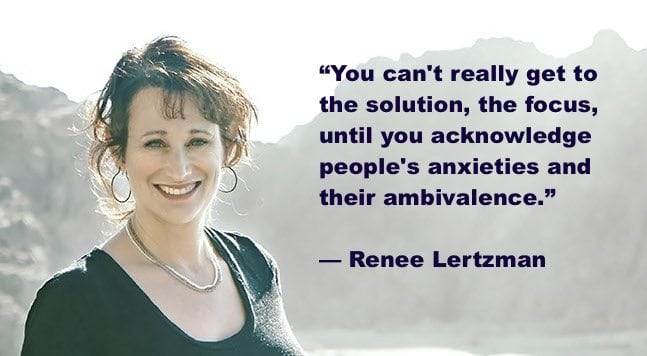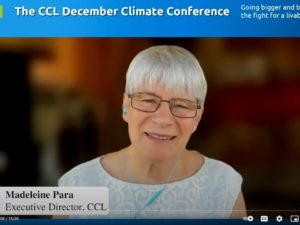On CCL’s call: Understanding emotions about climate change
By Flannery Winchester
Each month, Citizens’ Climate Lobby hosts an international call featuring a guest speaker to educate listeners on topics related to climate change and our Carbon Fee and Dividend proposal.
The guest speaker for April 2016 was Dr. Renee Lertzman, a practicing climate change engagement specialist, applied researcher and senior advisor for the Center for Sustainable Energy, along with teaching Psychology and Environmental Education and Communications at Royal Roads University. Her most recent book is called “Environmental Melancholia: Psychoanalytic Dimensions of Engagement,” and she joined our April call to discuss the intersection of psychology and climate change advocacy.
As many of us know already, successful environmental advocacy really comes down to human relationships: Relationships with our neighbors, potential CCL members, our elected representatives and their staff. And because those relationships are built with thinking, feeling people, it’s crucial to understand how people engage with climate change on a psychological level. Dr. Lertzman said, “Whether you’re an engineer, a technician, a campaigner or a communications professional, understanding the psychological dimensions of climate change is completely integral and essential to be as effective as we can be.”
To get people engaged, they have to get emotional
When advocating for climate change legislation like Carbon Fee and Dividend, the goal is to get people at all levels engaged. But what does “engagement” really mean? “What it often means is that we want to get people to care, we want to get people motivated, and we want to make people act,” Dr. Lertzman said. Unfortunately, she pointed out, our efforts are often ineffective.
But why? It turns out, according to research done by British psychologists Drs. Lorenzoni and Whitmarsh, the environmental engagement we want can’t happen unless people are involved on “cognitive, behavioral and affective levels.” The key is that “affective” part — the emotional dimension. In order to fully reach people and galvanize them toward climate action, we have to understand how they emotionally engage with the topic of climate change.
Climate change — it’s scary stuff
So let’s take a look at that emotional level. Imagine you know nothing about climate change — you’re just living your life, working a steady job, and enjoying your family. Suddenly someone on social media or at a dinner party starts talking about the danger of climate change, and the ways it could devastate YOUR community. You start worrying about more flooding, more heat waves, unpredictable superstorms… pretty scary, right?
Dr. Lertzman pointed out, getting that information “can arouse such profound anxiety — that we’re not even conscious of — that we can end up in a place we don’t want to be.” And that place is a place of defensiveness. People might try to minimize the threat by telling themselves it’s not all that bad. People might be so frightened at the prospect that they simply say, “I don’t want to hear about it.” And this is normal, Dr. Lertzman explained. Our natural tendency is to protect ourselves from distress in situations that are unthinkable — like climate change. “Fear and anxiety literally shut down our frontal lobe, so we’re unable to engage in the kind of foresight that’s needed right now.”
So that’s a very critical piece of the puzzle, Dr. Lertzman said. “Working with these dynamics is just as important as understanding the science, the policy, the technology — every aspect that we think is critical to climate work. Understanding the affective, or the emotional, is equally as important.” Once we know where people are emotionally, we can connect and truly engage them.
Feeling safe leads to success
The first step to drawing people out of that anxious, fearful space around climate change is making them feel safe. But it’s not practical for us to all sit around in a therapist’s office together, so Dr. Lertzman said, “We’re going to have to innovate ways to create safety.” This includes listening, creating a safe environment where people can feel what they’re feeling, and developing skills such as motivational interviewing and open questions that help us be more effective in our interactions.
Dr. Lertzman conducted some qualitative research to explore this very point. She designed interviews and focus groups with 30 U.S. Republicans intended to cultivate conversation. Nobody was asked point blank, “What do you think about climate change?” or “What do you think about a carbon tax?” In the absence of those direct questions, Dr. Lertzman found that people shared really diverse concerns, internal conflict and desires. Dr. Lertzman even remembers hearing a very conservative man in the group say, “If I knew that climate change was real, I would become a climate activist.”
“What [this research] demonstrates is irrefutable,” Dr. Lertzman said. “When we are able to really acknowledge people’s anxieties and concerns, we’re more able to move them into the aspirational.” As soon as we really listen to people’s worries and anxieties, we can directly address them and move closer to a solution — together.
Hear Dr. Lertzman’s full remarks on our April 2016 podcast, and follow her on Twitter at @reneelertzman.






